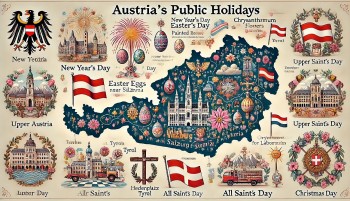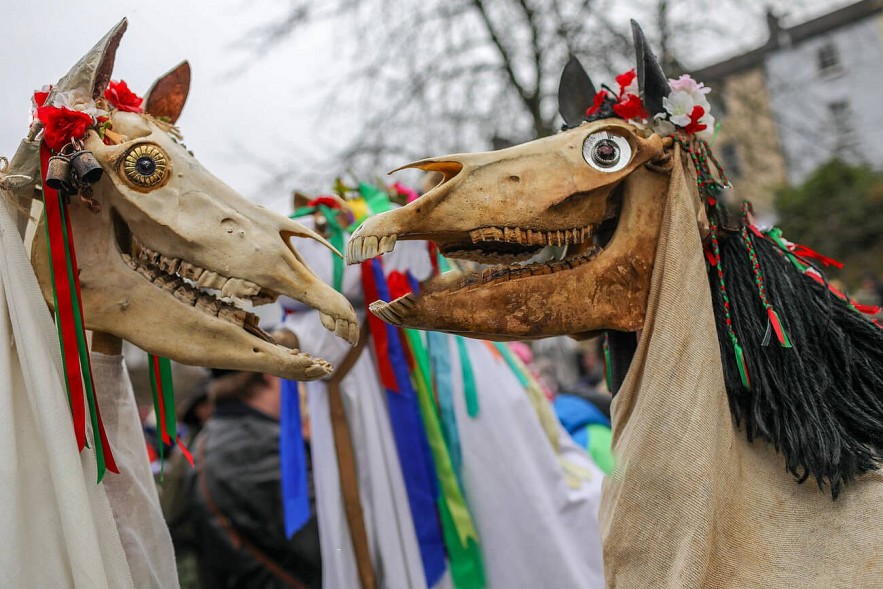20 Unique and Weirdest Ways Christmas Is Celebrated Around the World
Christmas is celebrated in almost every corner of the world, but its manifestations are as diverse as the cultures that embrace it. While some countries stick to well-known customs like exchanging gifts or decorating Christmas trees, others have unique and unconventional ways of celebrating that are deeply rooted in their history, beliefs, and local traditions. These peculiar festivities reflect not just the global spirit of Christmas but also the richness of cultural expression, making the holiday season a fascinating tapestry of human creativity.
For instance, in Japan, Christmas is a festive yet commercial holiday where families line up to buy fried chicken from KFC—a tradition born out of a clever marketing campaign in the 1970s. In contrast, Austria leans into its folklore, celebrating Krampusnacht, a night where the fearsome Krampus punishes naughty children. In Catalonia, Spain, children interact with “Caga Tió,” a log that "poops" presents, adding humor and fun to the festivities. Meanwhile, in Venezuela, the streets of Caracas come alive as residents roller-skate to church, creating a scene that’s both whimsical and heartwarming.
These traditions highlight how Christmas adapts to local customs, resulting in celebrations that are sometimes bizarre, occasionally humorous, but always meaningful to the communities that practice them. From spider-web decorations in Ukraine to pudding-throwing rituals in Slovakia, every tradition has a story to tell. Understanding these unique customs not only broadens our appreciation for the holiday but also reminds us of the shared joy and unity that Christmas brings across the globe, even in the quirkiest ways.
In this article, we explore 20 of the most unique and weird ways Christmas is celebrated, showcasing the endless creativity and diversity of holiday traditions worldwide.
20 Most Unique and Weird Ways Christmas is Celebrated Worldwide
1. Japan: Kentucky Fried Christmas
 |
| An employee of Japan Airlines shows off a plate of "AIR Kentucky Fried Chicken" |
In Japan, Christmas is less a religious celebration and more a festive occasion. A KFC marketing campaign in 1974, “Kentucky for Christmas,” suggested fried chicken as the perfect Christmas meal. This idea quickly took root, and today, families across Japan pre-order KFC buckets weeks in advance. The meal, complete with sides like cake and wine, has become synonymous with the holiday. It’s not just a dinner; it’s an event, often accompanied by festive decor and music. For many Japanese families, the tradition offers a fun and low-stress way to celebrate, especially since Christmas isn’t a public holiday in the country. This unconventional custom underscores the blending of global marketing with local holiday spirit.
 Japan Calendar 2025 - Full List of Public Holidays And Observances: Dates and Celebrations Japan Calendar 2025 - Full List of Public Holidays And Observances: Dates and Celebrations |
2. Austria: The Fearsome Krampusnacht
InAustria, Christmas comes with a twist of terror. On December 5th, the eve of St. Nicholas Day, Austrians celebrate Krampusnacht. Krampus, a horned, demonic figure, roams the streets, often accompanied by St. Nicholas. While Nicholas rewards good children, Krampus punishes the naughty ones, sometimes with a bundle of sticks or chains. Adults often dress as Krampus, scaring children and participating in parades. This tradition stems from Alpine folklore, portraying Krampus as a counterpart to Santa Claus. Over time, Krampusnacht has evolved into a festive, if eerie, event with elaborate costumes and lively gatherings. The custom highlights the duality of reward and discipline during the holiday season, making it truly unique.
 Austria Calendar 2025 - Public & Regional Holidays: Significance and Activities Austria Calendar 2025 - Public & Regional Holidays: Significance and Activities |
3. Catalonia, Spain: Caga Tió, the Pooping Log
In Catalonia, the festive season involves a log with a face and a red hat called “Caga Tió,” meaning “Pooping Log.” Beginning on December 8th, families “feed” the log small treats like nuts and fruits, covering it with a blanket to keep it warm. On Christmas Eve, children sing songs and beat the log with sticks to make it “poop” gifts and sweets. The ritual ends with laughter as the final surprise emerges—a less glamorous item, like an onion or garlic. This quirky custom adds humor to the holiday season and emphasizes Catalonia’s creative approach to family traditions, blending whimsy and joy in an unforgettable way.
4. Venezuela: Roller-Skating to Church
Christmas in Caracas, Venezuela, takes an energetic turn with a unique morning tradition. Streets are closed to cars so people can roller-skate to church for early morning Mass. The tradition, believed to have started decades ago, fills the city with joy and laughter as skaters of all ages glide through the streets. Children often tie strings to their skates, and onlookers give them a tug as a sign of encouragement. After church, the skating families return home for a hearty breakfast of traditional Venezuelan treats, such as “hallacas” (meat-filled cornmeal dough) and “pan de jamón” (ham bread). This lighthearted tradition embodies community spirit and festive energy.
5. Ukraine: Spider Web Decorations
 |
| Christmas trees sparkle with spider web decorations in Ukraine |
In Ukraine, Christmas trees sparkle with spider web decorations, a tradition rooted in folklore. Legend has it that a poor widow and her children couldn’t afford decorations for their tree. On Christmas morning, they discovered that friendly spiders had spun intricate webs overnight, turning their humble tree into a shimmering masterpiece. Today, Ukrainians honor this story by adorning trees with glittery artificial webs and spiders, symbolizing luck and prosperity for the coming year. The custom is both a nod to the nation’s storytelling heritage and a creative twist on holiday decor, adding an enchanting, magical feel to the season.
6. Norway: Broom-Hiding Tradition
In Norway, Christmas Eve comes with an old superstition: hiding all brooms in the house. According to folklore, witches and evil spirits emerge during this time, searching for brooms to ride into the night. Families ensure no broom is left visible to avoid unwanted attention from these supernatural visitors. Though modern Norwegians may treat this as a playful tradition, it remains a fascinating glimpse into the country’s historical beliefs. Paired with candlelit dinners and cozy gatherings, the tradition creates a unique blend of mystery and warmth during the festive season, making Norwegian Christmas celebrations truly memorable.
7. Greenland: Whale Skin and Fermented Birds
Christmas in Greenland offers a unique culinary experience that connects deeply with Inuit culture. Traditional festive dishes include “mattak,” raw whale skin with a layer of fat, and “kiviak,” a delicacy made by fermenting auk birds in sealskin for several months. These acquired tastes are enjoyed during Christmas feasts, reflecting Greenland's reliance on local resources and its Arctic heritage. Sharing these meals during the holidays underscores the importance of community and tradition. While unusual to outsiders, these dishes carry significant cultural value, making Greenland’s Christmas celebrations an extraordinary expression of indigenous identity.
8. Czech Republic: Predicting Marriage with a Shoe
Unmarried women in the Czech Republic have a peculiar way of predicting their marital future on Christmas Eve. They stand with their backs to the door and toss a shoe over their shoulder. If the shoe lands with the toe pointing toward the door, it’s believed they will marry soon. This tradition, passed down through generations, adds excitement and anticipation to the holiday festivities. Families often join in the fun, teasing and celebrating the results. While lighthearted, the ritual reflects the Czech emphasis on family connections and the holiday as a time for hope and future aspirations.
 Czech Calendar 2025 - Public & Regional Holiday: Significance and Activities Czech Calendar 2025 - Public & Regional Holiday: Significance and Activities |
9. Philippines: The Giant Lantern Festival
In San Fernando, the “Christmas Capital of the Philippines,” the Giant Lantern Festival, or “Ligligan Parul,” is a spectacular highlight. Communities compete to create enormous lanterns, often over 20 feet tall, illuminated by intricate patterns of lights. These lanterns symbolize the Star of Bethlehem and reflect Filipino craftsmanship and devotion. The festival, held on the Saturday before Christmas Eve, draws visitors from across the country and abroad. Music, food, and dancing accompany the event, making it a vibrant celebration of faith and creativity. This dazzling display captures the warmth and festive spirit of Filipino Christmas traditions.
10. Italy: La Befana the Christmas Witch
 |
| La Befana the Christmas Witch |
In Italy, La Befana, a kind-hearted witch, visits children on the night of January 5th, marking the end of the Christmas season. Legend says she missed her chance to join the Wise Men on their journey to Bethlehem but now delivers gifts to children, hoping to find the Christ child. Children hang stockings by the fireplace for Befana to fill with sweets or coal, depending on their behavior. Celebrations include feasts and fairs, with Befana often appearing in parades. This tradition blends Christian themes with folklore, offering a magical conclusion to the festive season in Italy.
11. South Africa: Fried Christmas Caterpillars
In South Africa, Christmas feasts often feature an unusual delicacy: deep-fried caterpillars of the Emperor Moth. These caterpillars, also known as “Christmas worms,” are considered a special treat during the holiday season. High in protein and rich in festive symbolism, they are believed to bring good fortune for the coming year. For many South Africans, especially in rural areas, this tradition reflects the blending of Christmas celebrations with local food practices and cultural heritage. Fried to a crispy perfection, the caterpillars are enjoyed as a snack or added to festive meals, offering a unique culinary twist to the season.
 2025 South Africa Calendar - Full List of Public Holidays, Observances And Celebrations 2025 South Africa Calendar - Full List of Public Holidays, Observances And Celebrations |
12. Germany: The Christmas Pickle
The German tradition of the Christmas pickle involves hiding a pickle-shaped ornament deep within the Christmas tree. On Christmas morning, the first child to find the pickle receives an extra gift, while some believe it also brings good luck for the year ahead. Though its origins are debated (some claim it was popularized in America), the tradition remains a fun activity for families. It encourages children to carefully observe the tree’s decorations, adding an element of excitement and competition to Christmas morning. This quirky custom blends festive cheer with a dash of holiday mystery.
 German Calendar with the Public Holidays, Observances And Celebrations German Calendar with the Public Holidays, Observances And Celebrations |
13. Iceland: Yule Lads and the Yule Cat
In Iceland, the Christmas season is ruled by folklore featuring 13 mischievous Yule Lads and a fearsome Yule Cat. The Yule Lads visit children over the 13 nights leading to Christmas, leaving gifts for those who behave or rotten potatoes for the naughty. Meanwhile, the Yule Cat, a giant feline, is said to devour anyone who doesn’t receive new clothes before Christmas Eve. These legends, steeped in Icelandic storytelling, add a playful yet eerie tone to the holidays. Today, the Yule Lads have taken on a more humorous role, but the traditions remain a cherished part of Icelandic Christmas celebrations.
14. Portugal: Honoring the Dead with Consoda
In Portugal, the Christmas morning “consoda” feast carries a poignant tradition: setting extra places at the table for deceased relatives. Families believe that including their loved ones in the celebration brings good fortune and ensures their blessings for the coming year. The table is filled with traditional Portuguese dishes such as codfish, boiled potatoes, and sweet rice pudding. This practice reflects the deep respect Portuguese culture holds for family ties, both past and present. The solemn yet comforting ritual transforms Christmas into a time of remembrance, unity, and hope.
 Portugal Calendar 2025 - Public & Regional Holidays, Significance and Activities Portugal Calendar 2025 - Public & Regional Holidays, Significance and Activities |
15. Mexico: Night of the Radishes
 |
| Night of the Radishes |
On December 23rd, the Mexican city of Oaxaca comes alive with “Noche de Rábanos,” or Night of the Radishes. Artisans carve oversized radishes into intricate designs, often depicting nativity scenes, religious symbols, or cultural icons. The festival includes a lively competition, drawing spectators who marvel at the creativity on display. The tradition dates back to colonial times, when farmers would carve radishes to attract customers at markets. Today, it has grown into a celebrated event that combines art, agriculture, and Christmas cheer, making it one of Mexico’s most unique holiday traditions.
16. Slovakia: Pudding Ceiling Toss
In Slovakia, Christmas comes with a messy yet meaningful ritual. The eldest man in the household flings a spoonful of “loksa,” a traditional pudding, at the ceiling. The more pudding that sticks, the more prosperity and good fortune the family is believed to have in the coming year. This playful tradition often turns into a family event, with laughter and good-natured teasing. While unconventional, it underscores the importance of family bonds and shared joy during the festive season. The pudding toss adds a humorous and symbolic touch to Slovak Christmas celebrations.
17. Guatemala: Burning the Devil
On December 7th, Guatemalans celebrate “La Quema del Diablo,” or Burning the Devil, a pre-Christmas tradition that involves lighting bonfires and burning effigies of the devil. This act symbolizes cleansing homes of evil spirits and negative energy to prepare for the holy season. Streets fill with the crackling sounds of firecrackers and the warmth of flickering flames. The tradition blends Catholic influences with indigenous practices, reflecting Guatemala’s rich cultural heritage. For many families, it’s a cathartic and celebratory event that marks the beginning of the Christmas season with light and renewal.
18. Wales: The Mari Lwyd Horse
 |
| The Mari Lwyd tradition involves a horse’s skull |
In Wales, the Mari Lwyd tradition involves a horse’s skull mounted on a pole, carried by participants draped in white sheets. This eerie figure travels door-to-door, accompanied by a group that sings and engages in witty rhyming battles with household members. If the Mari Lwyd and its group win, they are invited inside for food and drink. The custom, which dates back to pre-Christian times, symbolizes good luck and fertility. Though the horse’s skull may seem unsettling, the tradition is carried out with humor and festivity, making it a memorable part of Welsh Christmas culture.
19. Colombia: Little Candles Day
On December 7th, Colombians kick off the Christmas season with “Día de las Velitas,” or Day of Little Candles. Streets, homes, and public spaces are illuminated with thousands of candles and lanterns, creating a magical atmosphere. The tradition honors the Virgin Mary’s Immaculate Conception and has evolved into a communal celebration of light, hope, and faith. Families often gather to light candles together, sharing food and music. The vibrant displays make it one of Colombia’s most visually stunning and heartfelt holiday traditions, symbolizing unity and the festive spirit.
 Colombia Calendar 2025 - Public & Regional Holiday: Significance and Celebrations Colombia Calendar 2025 - Public & Regional Holiday: Significance and Celebrations |
20. Sweden: The Gävle Goat
In Gävle, Sweden, a giant straw goat is constructed every year to mark the start of Advent. Known as the Gävle Goat, this structure is over 40 feet tall and represents the traditional Yule Goat, an ancient Scandinavian symbol of fertility. However, the goat has become infamous for another reason: attempts to burn it down. Since its inception in 1966, vandals have set the goat ablaze numerous times, turning its survival into a thrilling game. Whether it survives or not, the Gävle Goat has become a beloved and quirky part of Swedish Christmas festivities.
 Sweden Calendar 2025 - Public & Regional Holiday: Significance and Activities Sweden Calendar 2025 - Public & Regional Holiday: Significance and Activities |
Conclusion
Christmas is more than just a holiday; it is a celebration of cultural diversity, creativity, and shared human experiences. The unique and weird traditions explored here highlight how each country infuses its history, beliefs, and values into the festive season. From Japan's fried chicken feasts to Iceland's mischievous Yule Lads, and from Guatemala's fiery devil burnings to Mexico's radish-carving artistry, these customs reveal the rich tapestry of global holiday practices.
These unconventional traditions remind us that the spirit of Christmas transcends boundaries. It’s a time for connection, reflection, and joy—whether through traditional religious practices, whimsical customs, or family-centered rituals. They also show that no matter how different our celebrations might be, the underlying themes of love, hope, and togetherness remain universal.
FAQs
Q: Why does Japan eat KFC on Christmas?
A: Japan’s tradition of eating KFC for Christmas originated in 1974 when the fast-food chain launched a marketing campaign suggesting fried chicken as the perfect holiday meal. The idea quickly became a national trend, and now families pre-order KFC buckets weeks in advance to celebrate Christmas.
Q: What is the story behind Ukraine’s spider web decorations?
A: Ukrainian spider web decorations are inspired by a folk tale about a poor widow who couldn’t afford Christmas decorations. On Christmas morning, her tree was miraculously covered in beautiful spider webs spun by friendly spiders. Today, these decorations symbolize good luck and prosperity.
Q: How does Venezuela celebrate Christmas with roller-skating?
A: In Caracas, Venezuela, people roller-skate to early morning Mass on Christmas Day. Streets are closed to traffic to allow safe passage for the skaters, making it a joyful and unique way to celebrate the holiday. Families return home afterward to enjoy a traditional breakfast.
Q: What is the significance of the Yule Cat in Iceland?
A: The Yule Cat is a mythical creature in Icelandic folklore that is said to eat people who don’t receive new clothes before Christmas Eve. It’s part of the larger tradition of the Yule Lads, mischievous characters who visit children during the holiday season.
Q: Why do Slovakians throw pudding at the ceiling?
A: In Slovakia, the eldest man in the family flings a spoonful of “loksa” pudding at the ceiling during Christmas dinner. The amount that sticks is believed to predict the family’s luck and prosperity for the coming year.
Q: What happens during Mexico’s Night of the Radishes?
A: On December 23rd, in Oaxaca, Mexico, artisans carve radishes into intricate designs such as nativity scenes and cultural motifs. This event, known as Noche de Rábanos, is a festive competition that celebrates creativity and community spirit.
Q: Why do Norwegians hide brooms on Christmas Eve?
A: According to Norwegian folklore, witches and evil spirits emerge on Christmas Eve to steal brooms for flying. To prevent this, families hide their brooms, turning this superstition into a playful holiday tradition.
Q: What is the Gävle Goat, and why is it often burned?
A: The Gävle Goat is a giant straw goat erected annually in Gävle, Sweden, as a symbol of Christmas and the traditional Yule Goat. However, vandals have frequently attempted to burn it down, turning its survival into a quirky, unofficial game that has gained international attention.
Q: What is Krampusnacht in Austria?
A: Krampusnacht, celebrated on December 5th, features Krampus, a horned, demonic figure who punishes naughty children. The event includes parades where people dress as Krampus, creating a thrilling contrast to the kindness of St. Nicholas.
Q: How does Portugal honor the dead during Christmas?
A: During the Christmas morning feast known as “consoda,” Portuguese families set extra places at the table for deceased loved ones. This tradition is believed to bring good fortune and ensures the blessings of ancestors for the coming year.



























